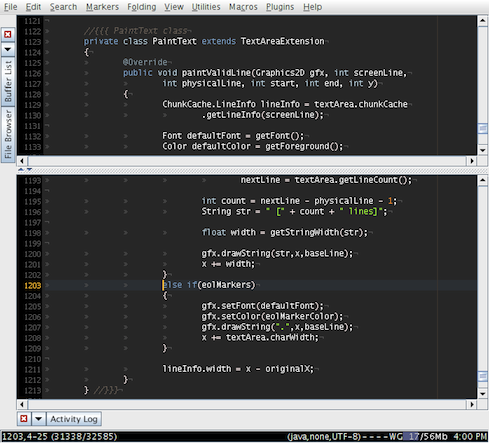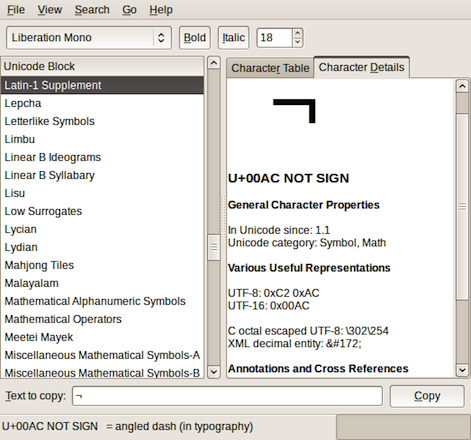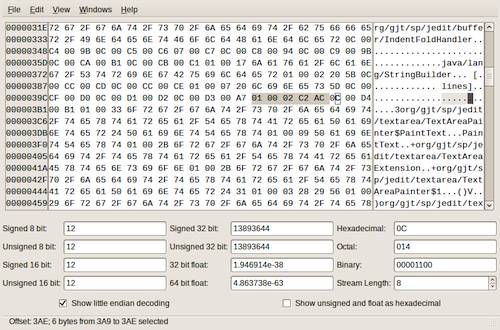Changing the end-of-line marker in jEdit without recompiling
14 January 2011
jEdit is a great text editor. It has all the features you’d expect from a modern text editor and, being written in Java, it’s highly portable. One feature that I make extensive use of is the “End of line markers” which allow me to easily see if there are any extraneous spaces at the ends of lines. But one thing that has always bothered me about jEdit’s end-of-line (EOL) markers is that they’re displayed as periods. Mostly, displaying periods in comments often leads to me thinking that I’m at the end of a sentence when I’m not. Some programming languages also feature periods as a part of their syntax, which can also lead to confusion.
Unfortunately, there’s no setting in jEdit that allows me to change the character used for the EOL marker, but that doesn’t mean it’s unchangeable! Since jEdit is open-source, one option is to modify the source code and recompile the application. However, even if I had the JDK installed, I don’t feel like waiting for jEdit to compile. The next best option (in my mind, anyway) is to fire up the good ol’ hex editor and change the bytecode. That’s exactly what I did.

First, some background on JAR and class files. A JAR file is simply a ZIP file with a .jar extension, inside of which is a hierarchy of class files. A class file is a binary file with a particular structure that includes, among other things, the constant pool and the bytecode itself. The constant pool consists of an array of any literal data that appeared in the source code. Each constant in the pool is prefixed with one byte representing the type. For strings, the type is 01 followed by 2 bytes that represent the number of bytes in the string (high order byte first), and then the string bytes encoded as (slightly modified) UTF-8.
Browsing through the jEdit JavaDocs, I noticed that org.gjt.sp.jedit.textarea.TextAreaPainter has some methods pertaining to EOL markers (namely getEOLMarkersPainted() and getEOLMarkerColor()), so that seemed like the natural starting point. Looking at the source code for TextAreaPainter, I found the line of code that draws the period (line 1207 in jEdit 4.3.2). That line happens to be part of the PaintText private class.
Since the period is represented in the source as a string literal, the compiler will add the literal to the constant pool in the class file. This is particularly handy, since changing the period to another character only requires changing the one literal in the constant pool.
First, I unzipped the jedit.jar from my jEdit installation into a directory. I then navigated to org/gjt/sp/jedit/textarea and opened the file TextAreaPainter$PaintText.class with a hex editor. Since most hex editors (including mine) display non-printing bytes as periods, it seems like locating the string in the constant pool was like finding a particular piece of hay in a haystack. However, since the period we’re looking for is represented by the single byte 2E in UTF-8, it was actually relatively straightforward. To quickly find the constant pool, I searched for another string that was easier to find: " lines]" from line 1196 in the source. From there, I found the next 2E byte. To verify that this was part of the constant pool, I inspected the preceding 3 bytes: 01 00 01, that is, this 2E is a string (01) of one byte (00 01). Replacing the period with another single-byte character is easy enough: just overwrite the 2E with another byte (for example, 7E for "~"). But the character I chose, the ¬ sign, is encoded with 2 bytes in UTF-8: C2 AC, as shown by the character map:

Normally, adding a byte to a binary file can be disastrous. Many types of files contain information about the length of the file or offsets in the header. Class files don’t, however. All offsets in the class file are specified as offsets from the end the constant pool. This is good news for those of us who want to modify those constants, since it saves some work.
But we can’t just add the extra byte. We also have to change the length information. That’s easy enough: I just changed the 00 01 to 00 02. Then, to replace the period, I changed the 2E to C2, and inserted the AC directly afterwards. My final constant is 01 00 02 C2 AC.

After saving the class file, I zipped the directory back into a JAR, opened jEdit, and, lo and behold, my EOL markers had changed!
More detailed information about Java class files can be found in The Java Virtual Machine Specification, chapter 4.
My modified JAR file can be downloaded here. It should be substitutable with the stock jedit.jar, the only change is the EOL marker as described above.